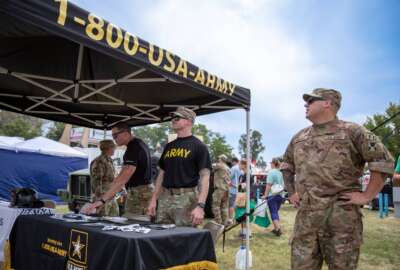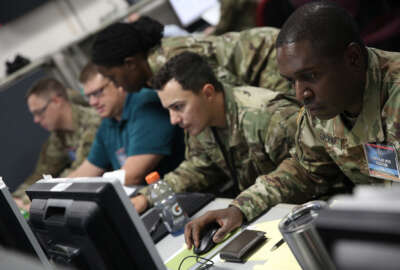Fort Knox has its own booster club
Fort Knox has a different mission than it historically did. That's because of the work the Base Realignment and Closure Commission did in the early 2000s.
The storied Fort Knox has a different mission than it historically did. That’s because of the work the Base Realignment and Closure Commission did in the early 2000s. Fort Knox still houses gold and has a human resources function. For details, the Federal Drive Host Tom Temin talked with Jim Iacocca, the President of the Knox Regional Development Alliance.
Interview Transcript:
Tom Temin Well, tell us about Fort Knox. I mean, everybody knows the gold bullion is stored there, but it’s much more than that. But it’s different than the missions it had in the 30s, 40s, 50, 60. So what goes on there?
Jim Iacocca You know. Absolutely. And I’m happy to share that. Interesting note. The gold bullion is actually not on Fort Knox. It’s right next to Fort Knox in the federal depository that shares space. So it’s run by the Treasury and not Fort Knox itself.
Tom Temin But it’s on the grounds.
Jim Iacocca Next to the grounds.
Tom Temin Next to the grass. So it’s not within the 109,000 acres.
Jim Iacocca It is not. No, sir. Not part of the 109,000 acres in Fort Knox.
Tom Temin Probably held in 1948. And everyone forgot. Right?
Jim Iacocca That’s probably a true statement. Yeah. So Fort Knox has really changed when it used to be the home of the Armor Center. It was important to the Army as it trained all armor forces in the army that since moved to Fort More, formerly Fort Benning down in Georgia, as you mentioned, under BRAC. And so while that was an emotional change for the community, the strategic importance of Fort Knox has grown quite considerably since BRAC. So at that time, it was the armor Center. You had one two star general that commanded the installation. Now there are 17 or 18 general officers on the installation. Nine general officer commands, one three star, soon going to two three stars, multiple two stars and one star. So what Fort Knox does for the Army is quite incredible. So Fifth Corps headquarters is at Fort Knox, one of four headquarters in the Army, and they are commanding, controlling all Army forces in Europe. That’s fifth Corps. Then you have recruiting command. No soldier comes in the Army anywhere in the world without being influenced by Fort Knox and Recruiting command. Cadet command. 75% of the officer corps that comes in the Army comes in through ROTC and cadet command commands, all ROTC formations and in human resources command global responsibility for the entire soldier life cycle. Then there’s first Theater Sustainment Command logistics support to the entire Middle East region, not just for the Army, but for all forces. And then first Army Division East, which certifies guard and reserve units for their wartime missions, for those guard and reserve units east of the Mississippi. And then there’s three reserve units Army Reserve Aviation Command commands, Army Reserve Aviation nationwide out of Fort Knox. Then there’s the 100th Division, which is reserved professional development nationwide, and the 84th Training Division, which does unit training on a regional basis. So there’s nine general officer commands right now where before there was one general officer command.
Tom Temin And will that change or get may be more important as the Army moves back to the division structure that it had before the war on terror, when it went to a brigade kind of emphasis.
Jim Iacocca I think, based on the organizations that are at Knox, that the mission at Knox won’t change, the support that they provide to the Army won’t change. And, you know, I don’t think any units are going to leave Fort Knox anytime soon. Now, there will be changes to our friends at Fort Campbell just down the road as division structure changes and potentially am not getting ahead of anything here. I don’t think potentially, depending on what kind of changes they make at Fort Campbell. Some of that growth might impact Fort Knox because Fort Knox still has capacity for growth.
Tom Temin Sure. And let’s talk about the alliance. The Knox Regional Development Alliance, I guess bases continue to be important economically to the areas that surround them. I don’t think they all have an alliance. What does the alliance do? How does it benefit Fort Knox and how does it benefit the area where you are in Kentucky?
Jim Iacocca Sure. So I think most military communities that are serious about their military community and their bases or posts have a military alliance. And we’re all part of an umbrella organization called the Association of Defense Communities. But the Knox Regional Development Alliance was actually created decades ago, and it was called the Core Committee when a group of businessmen and women realized the economic importance of Fort Knox to their region and to the economy and their livelihood. So they created this organization. It was a part time organization then. And then in 2017, they decided, you know, we need to get serious about this. And they created a full time organization. They named it the Knox Regional Development Alliance. And I was very privileged to be hired as the first full time president and CEO of the organization. The organization founded on four main goals, and that is to protect existing missions at Fort Knox right now and advocate for growth at Fort Knox that make sense for Fort Knox. Increased defense contractor spending in the region create opportunities for the community to partner with the installation and vice versa. And then to do everything we can to take care of soldiers and families as they come in to Fort Knox while they’re at Fort Knox. And then as they transition from Fort Knox.
Tom Temin We’re speaking with Jim Iacocca, president of the Knox Regional Development Alliance. Yeah, that’s an important point. You mentioned the interaction with the local community, because when you have a military base in an area, you don’t want it to be as if there’s a federal prison in the area. The only thing they have in common, maybe, is a fence or a wall around it. But really, I would think it’s healthy for both sides to have a porous kind of relationship where events interaction, it becomes a normalized part of the community, just like the big box store.
Jim Iacocca You know, I mentioned earlier all those units that are there. What’s really interesting about Fort Knox, about 22,000 people that work there, almost half of that workforce is a civilian workforce that lives off the installation. And so people are going on and off the installation all the time to work. They pay taxes in the community where before, you know, soldiers tend not to pay tax in the state that they’re working in unless they happen to be residents there. And so what’s nice about Fort Knox is, you know, since 911, all the posts were closed, but they have a really robust visitor’s program that you can go get registered. You can register for a year, and then you go on and off the post to use the golf course to use some of the other facilities that are on the installation. So they really do encourage people to come visit the installation. You know, the installation leadership talks about this all the time, that it’s your post, you’re tax payer. You live in the community, it’s your Fort Knox. Come visit it. And so they encourage people to come on the installation.
Tom Temin Yeah. On a big one like that’s probably just a great place to bicycle through or hike through, I imagine.
Jim Iacocca So there are some great trails on the installation and right off the installation, as a matter of fact. And then there’s places to bike. They’ve started to open more of the road to biking on the weekends. It’s easier on the weekends when there’s not so much activity in some of those ranges.
Tom Temin And getting to the contracting and economic development side, how do you encourage contracting and what types of goods and services are generally needed? You know, an arsenal might need something different from a base, and depending on the mission, you may have aircraft, you may have armor, artillery. Different types of things engender different types of contracting.
Jim Iacocca Sure. So when you look at Fort Knox, obviously it’s got its traditional brass cutting contracts, base maintenance contracts, janitorial contracts. And I think that’s common to everybody. But what’s a little bit different, based on the missions at Fort Knox now before Fifth Corps, it was almost all IT based or a lot of it contracts. And you know, now as we’re looking at more AI and more bot ability to do some things that bring some more a IT contracts into the region. And so there’s a lot of IT contractors and signalers that work there. And then with Fifth Corps did bring in a different piece because of the strategic communication requirements and some of the other things, but really it’s mostly database and it focused on Fort Knox.
Tom Temin And do you have local offices of national types of corporations nearby? Sometimes you see that a lot around bases.
Jim Iacocca The pandemic change things a little bit. Just about all the big folks that you could name had local offices. Now it seems that most of them are remote, but they all have local partners that have local offices. We have one contractor that has grown from 70 to over 200 employees in the region, their local contractor, but they partner with all the big ones. And so that kind of gives us big ones reach. We typically meet from Canada, we meet with the big contractors, and when they talk about coming in to compete for contracts at Fort Knox, they’ll often meet with us and talk with us. And, you know, at the right time, we’ll help connect them with the folks on the installation.
Tom Temin So someone could have a or a company could have a Silicon Valley body of knowledge, but have a really great Kentucky lifestyle if they wanted.
Jim Iacocca And so it at one point, there was a lot of that going on pre-pandemic. And then when that went away, and you probably know better than I did when that happened, hey, we can really hire employees from anywhere as long as they have connectivity. And that kind of did away with that. But there were a couple of organizations from the northeast that were looking at establishing an office, basically a data office here, based on the fact that we are relatively safe from climate impacts. And we have a very stable electrical grid here. And, you know, they were getting walloped in the Virginia Beach area and they’re like, let’s look for some other places. So they came to work for us. And, you know, we’re having conversation for them in the late 19th and early 20s. And then, as you know, the world changed, you know, like, hey, we can still hire Kentucky folks and we don’t have to pay for office space. Yeah.
Tom Temin Yeah, that sounds like a good plan. And you yourself are former Army.
Jim Iacocca I am. I retired out of Fort Knox in 2017.
Tom Temin And you stuck around.
Jim Iacocca It’s a wonderful area, you know is around Fort Knox and even up in Louisville and just where you can be and where Kentucky is located. I mean, Kentucky is a nice central location. We can be just about anywhere within a day’s drive.
Tom Temin Plus, the hunting and fishing is pretty good.
Jim Iacocca The hunting and fishing is actually very nice here. Yes.
Copyright © 2025 Federal News Network. All rights reserved. This website is not intended for users located within the European Economic Area.
Tom Temin is host of the Federal Drive and has been providing insight on federal technology and management issues for more than 30 years.
Follow @tteminWFED







